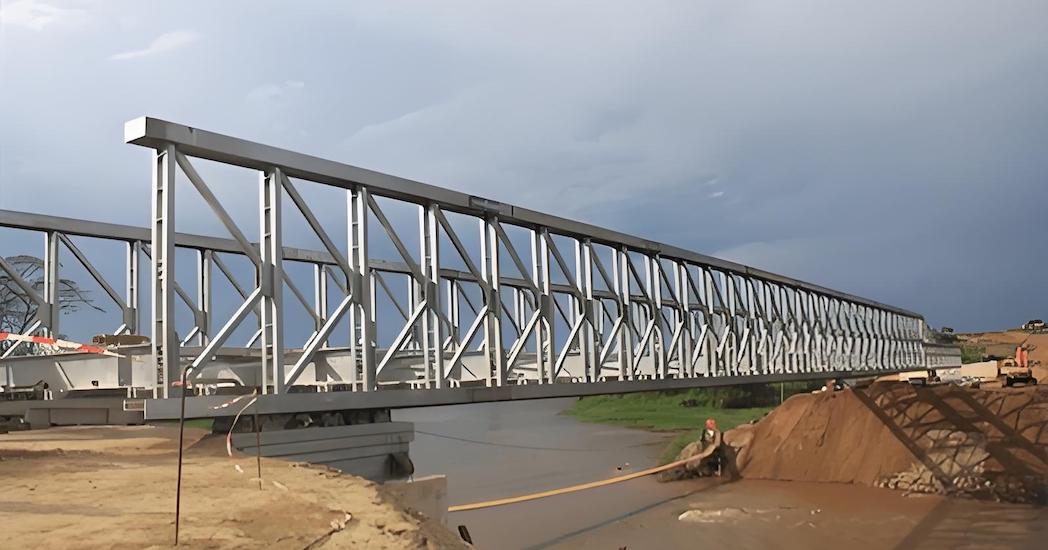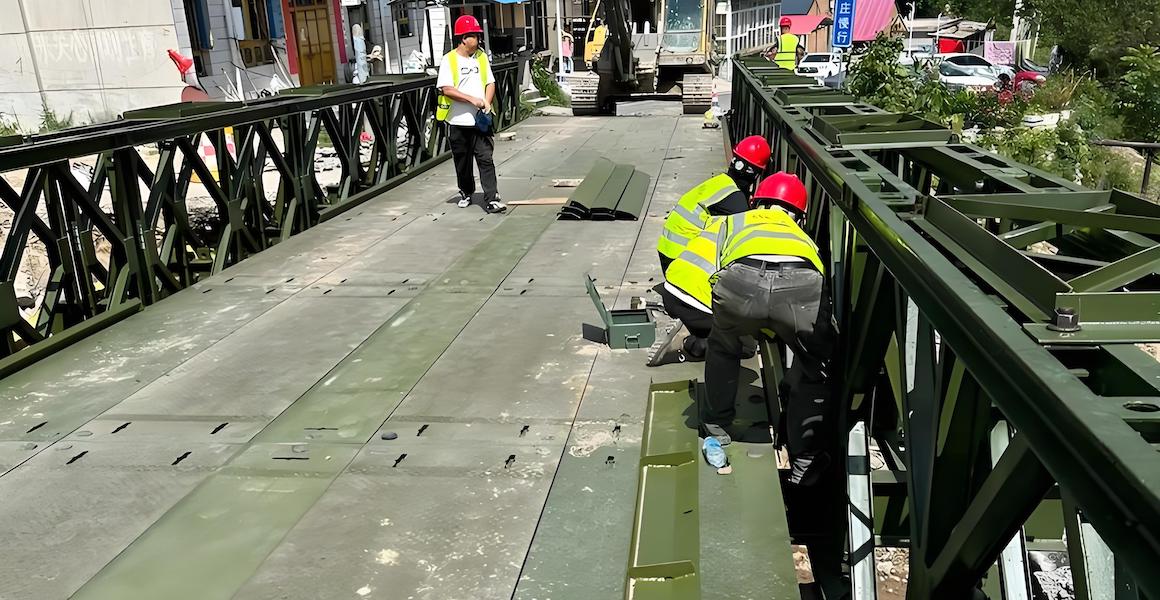Views: 211 Author: Site Editor Publish Time: 2025-11-04 Origin: Site









Content Menu
● Understanding Modular Bridges
>> Key Features of Modular Bridges
● The Installation Process of Modular Bridges
● Comparing Modular Bridges to Traditional Bridges
● Advantages of Modular Bridges
● Challenges of Modular Bridges
● Future Prospects of Modular Bridges
>> Integration with Smart Technologies
● Frequently Asked and Questions regarding Modular Bridges
>> 1. What are the typical lifespan and maintenance requirements for modular bridges?
>> 2. How do modular bridge costs compare to traditional bridge construction costs?
>> 3. What innovative materials are being used in modern modular bridge construction?
>> 4. Can modular bridges be customized for specific site conditions?
>> 5. What are the environmental benefits of using modular bridges?
The construction of bridges is a critical aspect of infrastructure development, facilitating transportation and connectivity. Among the various types of bridges, modular bridges have gained significant attention due to their innovative design and construction methods. This article explores the speed of installation of modular bridges compared to traditional bridges, highlighting the advantages, challenges, and future prospects of modular bridge technology.
Modular bridges are pre-fabricated structures that are manufactured off-site and then transported to the construction site for assembly. These bridges consist of standardized components that can be quickly assembled, allowing for rapid deployment in various environments. The modular approach not only speeds up the construction process but also enhances the quality and safety of the structures. This method is particularly beneficial in areas where traditional construction methods may be impractical due to environmental constraints or logistical challenges. By utilizing modular designs, engineers can create bridges that are not only functional but also adaptable to the specific needs of the location.
Modular bridges are characterized by several key features that contribute to their efficiency and effectiveness. These include:
Pre-fabrication: Components are manufactured in a controlled environment, ensuring high quality and precision. This process minimizes the risk of defects that can occur during on-site construction, leading to a more reliable final product.
Standardization: The use of standardized parts allows for easier assembly and reduces the need for custom designs. This standardization also facilitates quicker repairs and replacements, as parts can be easily sourced and installed.
Transportability: Modular components can be easily transported to remote or challenging locations, making them ideal for various applications. This transportability is crucial in emergency situations where rapid deployment is necessary, such as in disaster relief efforts.
Flexibility: Modular bridges can be designed for different spans and load capacities, accommodating a wide range of transportation needs. This flexibility allows for the construction of bridges that can serve both pedestrian and vehicular traffic, enhancing their utility.
Before the actual installation of a modular bridge, several preparatory steps are taken. This phase includes site assessment, design finalization, and the preparation of the foundation. The foundation must be designed to support the specific load requirements of the bridge and must be completed before the modular components arrive. During this phase, engineers conduct thorough analyses of soil conditions, environmental impacts, and traffic patterns to ensure that the bridge will meet all necessary safety and performance standards.
Once the foundation is ready, the modular components are delivered to the site. The assembly process typically involves the following steps:
Component Placement: The pre-fabricated sections are positioned on the foundation using cranes or other lifting equipment. This process is often completed in a matter of hours, significantly reducing the time the site is disrupted.
Connection: The sections are connected using bolts, welds, or other fastening methods, ensuring structural integrity. Advanced connection techniques can enhance the strength of the joints, contributing to the overall durability of the bridge.
Finishing Touches: After assembly, additional work such as installing guardrails, paving, and lighting is completed to make the bridge operational. This final phase is crucial for ensuring that the bridge meets all regulatory requirements and is safe for public use.
The installation of modular bridges can be completed in a matter of days or weeks, depending on the complexity and size of the structure. In contrast, traditional bridges often require months or even years for construction due to the extensive on-site work involved. The rapid installation of modular bridges not only minimizes disruption to local communities but also allows for quicker access to essential services and transportation routes.
One of the most significant advantages of modular bridges is the reduced construction time. Traditional bridges typically involve extensive site preparation, on-site fabrication, and lengthy curing times for concrete. In contrast, modular bridges benefit from pre-fabrication, allowing for simultaneous site preparation and component manufacturing. This parallel approach significantly shortens the overall project timeline, enabling communities to benefit from improved infrastructure much sooner.
Modular bridge construction often requires fewer labor hours compared to traditional methods. The pre-fabrication process reduces the need for skilled labor on-site, as much of the work is completed in a factory setting. Additionally, the simplified assembly process allows for quicker installation, further reducing labor costs and time. This efficiency can be particularly advantageous in regions facing labor shortages or where skilled labor is expensive.
Weather conditions can significantly affect the construction timeline of traditional bridges. Rain, snow, and extreme temperatures can delay on-site work and curing times. Modular bridges, however, are less susceptible to weather-related delays since much of the construction occurs indoors. This advantage allows for more predictable project timelines, which is essential for planning and budgeting in public infrastructure projects.
The reduced construction time and labor requirements associated with modular bridges lead to significant cost savings. Additionally, the use of standardized components can lower material costs, making modular bridges a more economical choice for many projects. These savings can be redirected towards other critical infrastructure needs, enhancing overall community development.
The pre-fabrication process allows for better quality control, as components are manufactured in a controlled environment. This results in higher quality materials and construction practices, leading to safer and more durable bridges. Enhanced quality control measures can also reduce the likelihood of future maintenance issues, further extending the lifespan of the bridge.
Modular bridges can have a lower environmental impact compared to traditional bridges. The reduced construction time minimizes disruption to the surrounding area, and the efficient use of materials can lead to less waste. Furthermore, the ability to transport modular components to remote locations reduces the need for extensive road construction and maintenance. This environmentally friendly approach aligns with global sustainability goals, making modular bridges an attractive option for eco-conscious projects.
While modular bridges offer many advantages, they also come with design limitations. The need for standardized components can restrict design flexibility, making it challenging to accommodate unique site conditions or specific aesthetic requirements. Engineers must carefully balance the benefits of standardization with the need for customized solutions that meet local needs and preferences.
Transporting large modular components can pose logistical challenges, especially in urban areas or remote locations. Ensuring that the components can be safely delivered to the site requires careful planning and coordination. This may involve securing permits for oversized loads, coordinating with local authorities, and scheduling deliveries to minimize disruption to traffic.
In some regions, regulatory frameworks may not fully accommodate modular bridge technology. Navigating the permitting process can be more complex for modular bridges, potentially delaying projects. Engaging with regulatory bodies early in the design process can help mitigate these challenges and ensure compliance with all necessary standards.
As technology continues to evolve, the potential for modular bridges will expand. Innovations in materials, design software, and construction techniques will enhance the capabilities of modular bridges, making them even more efficient and versatile. For instance, advancements in 3D printing and robotics could further streamline the manufacturing and assembly processes, reducing costs and improving precision.
With the growing recognition of the benefits of modular bridges, more governments and organizations are likely to adopt this technology. As successful projects demonstrate the effectiveness of modular construction, it is expected that the demand for modular bridges will increase. This trend may lead to the establishment of industry standards and best practices, further promoting the use of modular technology in infrastructure projects.
The future of modular bridges may also involve the integration of smart technologies. Incorporating sensors and monitoring systems can enhance the safety and maintenance of these structures, providing real-time data on their condition and performance. This data-driven approach can facilitate proactive maintenance, extending the lifespan of the bridge and ensuring its continued safety for users.
Modular bridges represent a significant advancement in bridge construction technology, offering numerous advantages over traditional methods. Their rapid installation, cost-effectiveness, and quality control make them an attractive option for infrastructure projects. While challenges remain, the future of modular bridges looks promising, with ongoing technological advancements and increased adoption paving the way for a new era in bridge construction. As the demand for efficient and sustainable infrastructure continues to grow, modular bridges are poised to play a crucial role in meeting these needs. By embracing this innovative approach, communities can enhance their transportation networks and improve overall quality of life.

Modular bridges typically have a lifespan of 50 to 100 years, depending on the materials used and environmental conditions. Maintenance requirements are generally lower than traditional bridges due to the high-quality pre-fabrication process, but regular inspections and minor repairs are still necessary to ensure safety and longevity.
Modular bridges often have lower overall costs compared to traditional bridges due to reduced construction time and labor requirements. While the initial investment in modular components may be higher, the savings in labor and time, along with lower maintenance costs, can make them more economical in the long run.
Modern modular bridges often utilize advanced materials such as high-performance concrete, fiber-reinforced polymers, and weathering steel. These materials enhance durability, reduce weight, and improve resistance to environmental factors, contributing to the overall efficiency of the bridge.
Yes, while modular bridges are based on standardized components, they can be customized to some extent to accommodate specific site conditions. Engineers can design modular systems that fit unique geographical and environmental requirements, ensuring that the bridge meets local needs.
Modular bridges offer several environmental benefits, including reduced construction waste, shorter construction times that minimize disruption to local ecosystems, and the ability to use sustainable materials. Their efficient design also allows for less energy consumption during transportation and installation.
